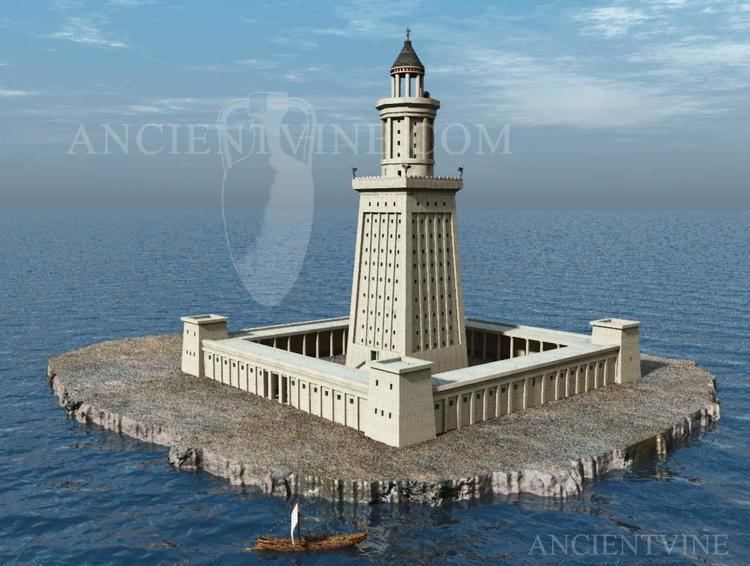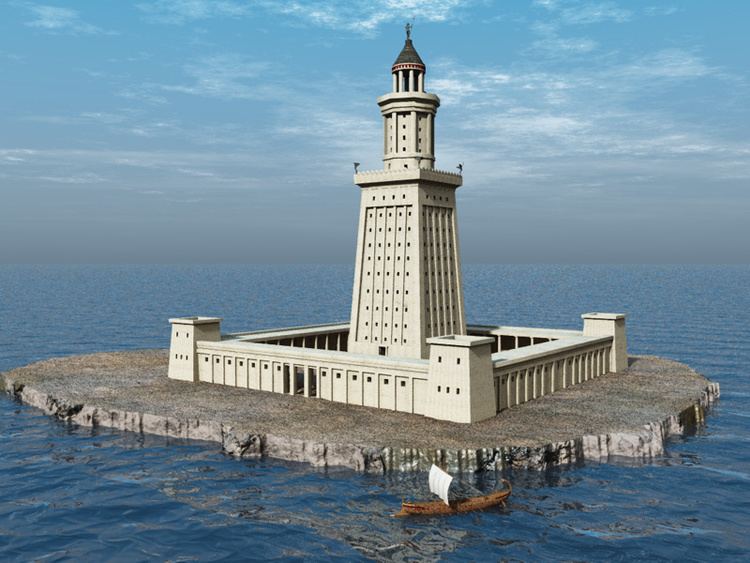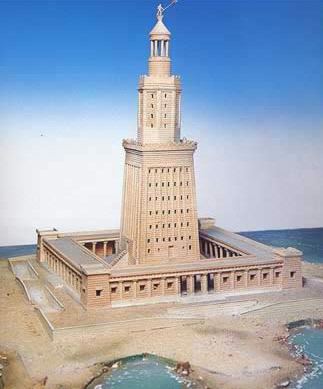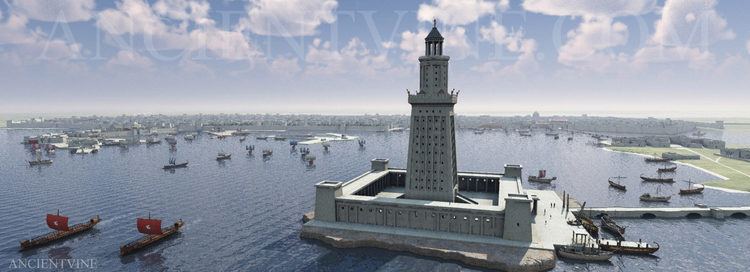Year first constructed c. 280 BC Foundation Stone Construction started 280 BC Destruction date 1480 | Deactivated 1303/1323 Height 120–137 m (394–449 ft) Opened 268 BC Destroyed by Earthquake Materials Masonry, Stone | |
 | ||
Location Pharos, Alexandria, Egypt Tower shape Square (below), octagonal (middle) and circular (top) Similar Colossus of Rhodes, Mausoleum at Halicarnassus, Statue of Zeus at Olympia, Temple of Artemis, Hanging Gardens of Babylon | ||
The lighthouse of alexandria remains underwater egypt
The Lighthouse of Alexandria, sometimes called the Pharos of Alexandria (/ˈfɛərɒs/; Ancient Greek: ὁ Φάρος τῆς Ἀλεξανδρείας, contemporary Koine [ho pʰá.ros teːs a.lek.sandréːaːs]), was a lighthouse built by the Ptolemaic Kingdom between 280 and 247 BC which was between 120 and 137 m (394 and 449 ft) tall. One of the Seven Wonders of the Ancient World, for many centuries it was one of the tallest man-made structures in the world. Badly damaged by three earthquakes between AD 956 and 1323, it then became an abandoned ruin. It was the third longest surviving ancient wonder (after the Mausoleum at Halicarnassus and the extant Great Pyramid of Giza) until 1480, when the last of its remnant stones were used to build the Citadel of Qaitbay on the site. In 1994, French archaeologists discovered some remains of the lighthouse on the floor of Alexandria's Eastern Harbour. The Ministry of State of Antiquities in Egypt has planned, as of late 2015, to turn submerged ruins of ancient Alexandria, including those of the Pharos, into an underwater museum.
Contents
- The lighthouse of alexandria remains underwater egypt
- The lighthouse of alexandria and the ancient port of alexandria
- Origin
- Construction
- Height and description
- Destruction
- Archaeological research and rediscovery
- Significance
- Pharos in culture
- In architecture
- In books
- References

The lighthouse of alexandria and the ancient port of alexandria
Origin

Pharos was a small island located on the western edge of the Nile Delta. In 332 BC Alexander the Great founded the city of Alexandria on an isthmus opposite Pharos. Alexandria and Pharos were later connected by a mole spanning more than 1200 metres (.75 mi), which was called the Heptastadion ("seven stadia"—a stadium was a Greek unit of length measuring approximately 180 m). The east side of the mole became the Great Harbour, now an open bay; on the west side lay the port of Eunostos, with its inner basin Kibotos now vastly enlarged to form the modern harbour. Today's city development lying between the present Grand Square and the modern Ras al-Tiin quarter is built on the silt which gradually widened and obliterated this mole, and Ras al-Tiin represents all that is left of the island of Pharos, the site of the lighthouse at its eastern point having been weathered away by the sea.
Construction

The lighthouse was constructed in the 3rd century BC. After Alexander the Great died of a fever at age 32, the first Ptolemy (Ptolemy I Soter) announced himself king in 305 BC, and commissioned its construction shortly thereafter. The building was finished during the reign of his son, the second Ptolemy (Ptolemy II Philadelphus). It took twelve years to complete, at a total cost of 800 talents, and served as a prototype for all later lighthouses in the world. The light was produced by a furnace at the top, and the tower was said to have been built mostly with solid blocks of limestone.

Strabo reported that Sostratus had a dedication inscribed in metal letters to the "Saviour Gods". Later Pliny the Elder wrote that Sostratus was the architect, which is disputed. In the second century AD the satirist Lucian wrote that Sostratus inscribed his name under plaster bearing the name of Ptolemy. This was so that when the plaster with Ptolemy's name fell off, Sostratus's name would be visible in the stone.
Height and description

Judith McKenzie writes that "The Arab descriptions of the lighthouse are remarkably consistent, although it was repaired several times especially after earthquake damage. The height they give varies only fifteen per cent from c. 103 to 118 m (338 to 387 ft), on a base c. 30 by 30 m (98 by 98 ft) square."
The fullest description of the lighthouse comes from Arab traveller Abou Haggag Youssef Ibn Mohammed el-Balawi el-Andaloussi, who visited Alexandria in A.D. 1166.
The Arab authors indicate that the lighthouse was constructed from large blocks of light-coloured stone, the tower was made up of three tapering tiers: a lower square section with a central core, a middle octagonal section, and, at the top, a circular section. At its apex was positioned a mirror which reflected sunlight during the day; a fire was lit at night. Extant Roman coins struck by the Alexandrian mint show that a statue of a Triton was positioned on each of the building's four corners. A statue of Poseidon or Zeus stood atop the lighthouse. The Pharos's masonry blocks were interlocked, sealed together using molten lead, to withstand the pounding of the waves.
Al-Masudi writes that the seaward-facing eastern side featured an inscription dedicated to Zeus.
Destruction
The lighthouse was badly damaged in the earthquake of 956, and then again in 1303 and 1323. Finally the stubby remnant disappeared in 1480, when the then-Sultan of Egypt, Qaitbay, built a medieval fort on the larger platform of the lighthouse site using some of the fallen stone.
The 10th-century writer al-Mas'udi reports a legendary tale on the lighthouse's destruction, according to which at the time of Caliph Abd al-Malik ibn Marwan (705–715) the Byzantines sent a eunuch agent, who adopted Islam, gained the Caliph's confidence, and secured permission to search for hidden treasure at the base of the lighthouse. The search was cunningly made in such a manner that the foundations were undermined, and the Pharos collapsed. The agent managed to escape in a ship waiting for him.
Archaeological research and rediscovery
In 1968 the lighthouse was rediscovered. UNESCO sponsored an expedition to send a team of marine archaeologists, led by Honor Frost, to the site. She confirmed the existence of the ruins representing part of the lighthouse. Due to the lack of specialists and the area becoming a military zone, exploration was put on hold.
Greek archaeologists led by Jean-Yves Emperor re-discovered the physical remains of the lighthouse in late 1994 on the floor of Alexandria's Eastern Harbour. Some of these remains were brought up and were lying at the harbour on public view at the end of 1995. A Nova program chronicled the discovery. Subsequent satellite imaging has revealed further remains. It is possible to go diving and see the ruins. The secretariat of the UNESCO Convention on the Protection of the Underwater Cultural Heritage are currently working with the Government of Egypt on an initiative to add the Bay of Alexandria (to include remains of the lighthouse) on a World Heritage List of submerged cultural sites.
Significance
Pharos became the etymological origin of the word 'lighthouse' in Greek (φάρος), Persian (Fānūs – فانوس), many Romance languages such as French (phare), Italian and Spanish (faro), Romanian (far) and Portuguese (farol), some Germanic languages like Norwegian (fyr), and even some Slavic languages like Bulgarian (far). In Russian, a derived word means "headlight" (fara – фара).
In 2008 it was suggested that the Pharos was the vertical yardstick used in the first precise measurement of the size of the earth.
Pharos in culture
The lighthouse remains a civic symbol of the city of Alexandria and of the Alexandria Governorate with which the city is more or less coterminous. A stylised representation of the lighthouse appears on the flag and seal of the Governorate and on many public services of the city, including the seal of Alexandria University.
